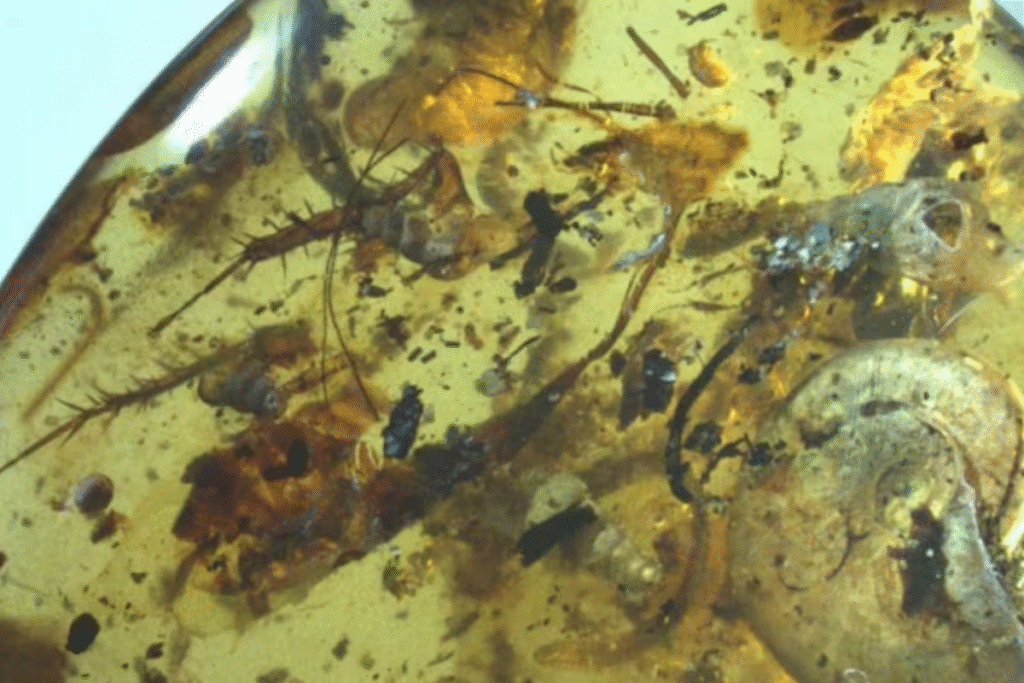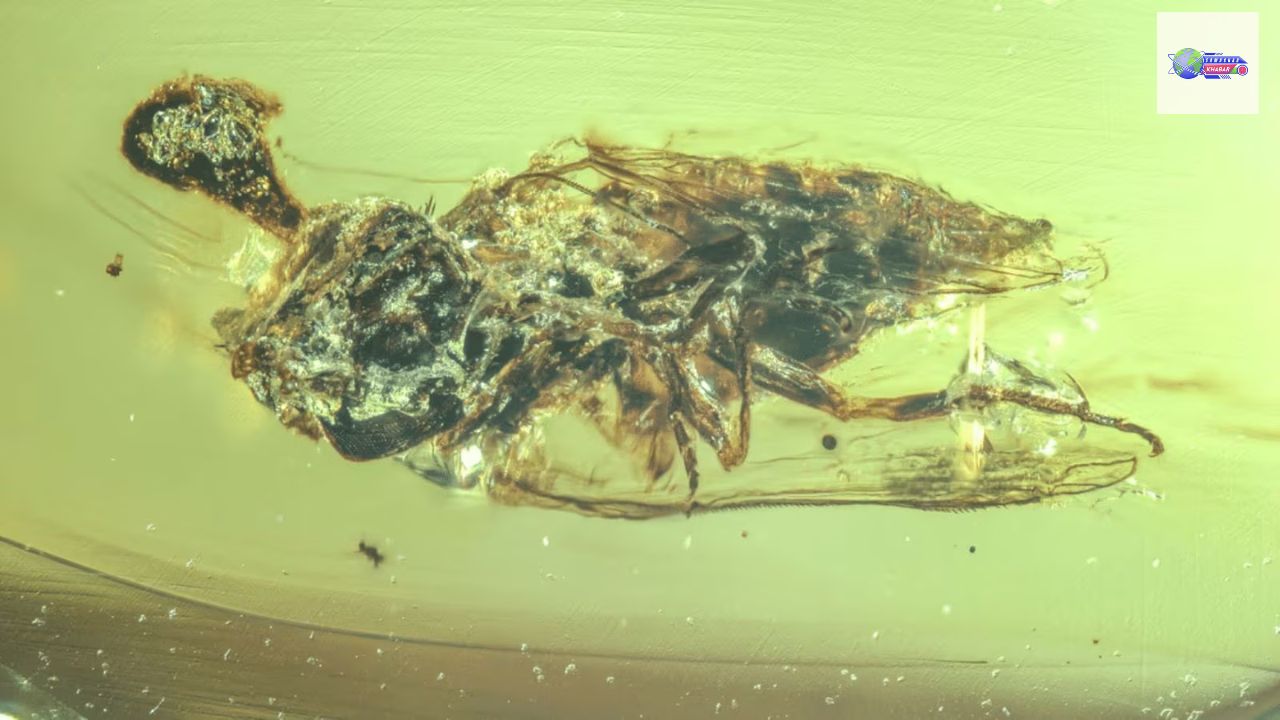Zombie Fungus: In a discovery that feels like science fiction, more than science; researchers have found two novel parasitic fungal species embedded in 99-million-year-old amber from Myanmar. These ancient fungi, Paleoophiocordyceps gerontoformicae and Paleoophiocordyceps ironomyiae, seem to have infected insect hosts, much like modern-day “zombie fungi” that control victims through their minds.
This is further evidence of the earliest prehistoric record of this fungus manipulation, thus snatching a rare moment in the Cretaceous time when dinosaurs were reigning the Earth. The fossilized insects-a fly and an ant with visible fungal structures protruding from their bodies-were perfectly encased inside tree resin that later turned into amber.
Ancient Fungi with Modern-Day Parallels
Zombie Fungus: Nowadays, fungi of the genus Ophiocordyceps show very scary and strange behavior. They infiltrate an ant or some other insect’s body, progressively taking over the insect’s central nervous system, and force it to climb vegetation. Once at the top, the insect is killed while the fungus erupts out of its body, spreads spores, and infects others.
What scientists had discovered in these amber specimens was that this macabre but fascinating strategy has an ancient origin, dating back almost 100 million years. This is the first time that such a precise parasitic interaction has been captured with such clarity in the fossil record.
Where Was It Found?
This particular amber type was recovered from the Kachin region of northern Myanmar, long long renowned for preserving ancient life-forms in fossil resins. Over the last ten years, from this very amber deposit, many astonishing discoveries have been made, including feathers, insects, and even naked baby dinosaurs!

Zombie Fungus: Against this backdrop, scientists applied high-power microscopy and 3D imageries to examine the fossils and revealed unequivocal fungal stalks emerging from the insects, signaling a clear parasitic attack of a bygone era.
Why This Matters for Evolutionary Science
Fungi are rarely preserved in the fossil record due to their delicate structures. So, finding two such well-preserved examples is not only rare but highly valuable to evolutionary biology. These fossilized fungi help scientists understand how host-parasite relationships evolved and how ancient ecosystems operated.
Also Read: Dowry Deaths in India: A Lingering Tragedy Despite Laws and Reform
Dr. Yuhui Zhuang, lead researcher from Yunnan University in China, stated that these fossils show a remarkable level of parasitic adaptation and suggest that complex biological interactions like behavioral manipulation were already established during the Cretaceous period.
Zombie Fungus: Then and Now
The discovery highlights that the so-called “zombie” behavior of modern fungi was likely inherited from ancient ancestors. Today, Ophiocordyceps is used as a biological control agent in agriculture, helping manage insect populations naturally.
Researchers believe that this kind of parasitic control might have played an ecological role even back then, possibly helping regulate insect populations in prehistoric rainforests.
A Glimpse Into a Long-Lost World
These ancient parasites offer more than just an eerie fascination, they reveal how life, even at a microscopic level, was intricately connected. Amber preservations serve as a time capsule, not only holding in their grasp the physical form of creatures but also their behaviors and biological associations.
Life Finds a Way- Even in the Shadows
Zombie Fungus: From its ancient 99-million-year snapshot, fungi reveal the intricacies and ingenuity of nature. Nature had systems of behavioral control and ecological balance established long before the formation of human intelligence or artificial intelligence. As we survey more amber deposits, we may continue unveiling the deep evolutionary secrets of the smallest-yet most sophisticated-forms of life.
From Prehistoric Parasitism to Present-Day Liberation
The discovery of zombie fungi in a 99-million-year-old fossil not only reveals the ancient wisdom of the natural world but is reflective of an eternal spiritual principle: that to control, to influence, and for the cycle of life and death to begin, are never recent affairs-the very sending forth from creation. Just as these fungi controlled their hosts for a purpose, ignorant men today are – being blinded – by ignorance, desire, and blind faith.
Through Tatvagyan (true spiritual knowledge), Sant Rampal Ji Maharaj states that without knowing the Supreme God Kabir, man remains a puppet of Kaal Brahm (the negative force of creation), and trapped in a cycle of suffering-enjoyment.
These zonked-out fossils are a proof to remind humanity that external control has been there since ages; freedom lay in awakening and not submission. Absolute salvation can come only by knowing the eternal laws of nature and connecting with the Supreme through Naam Diksha (initiation) from a truly enlightened Saint like Sant Rampal Ji Maharaj. Evolution may be a biological process-but salvation is spiritual. Read creation of nature and visit www.supremegod.org
FAQs about the discovery of 99-million-year-old zombie fungi
1. Where were the 99-million-year-old zombie fungi discovered?
Ans: In amber from the Kachin region of northern Myanmar.
2. What are the names of the two ancient fungi species found?
Ans: Paleoophiocordyceps gerontoformicae and Paleoophiocordyceps ironomyiae.
3. Which modern-day fungi genus shows similar parasitic behavior?
Ans: Ophiocordyceps.
4. What types of insects were infected by the ancient fungi?
Ans: A fly and an ant.
5. Why is this discovery important for science?
Ans: It provides rare fossil evidence of early parasitic behavior and helps understand the evolution of host-parasite relationships.

















